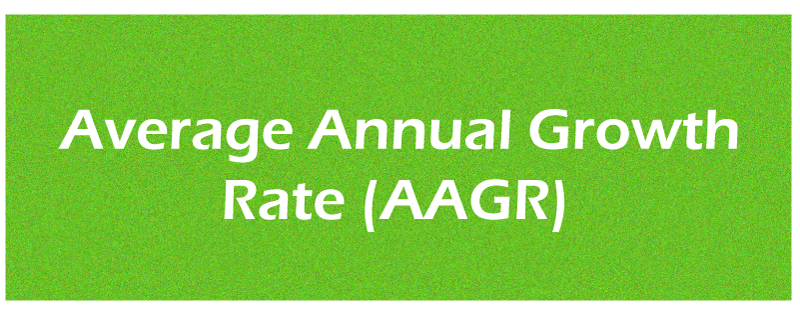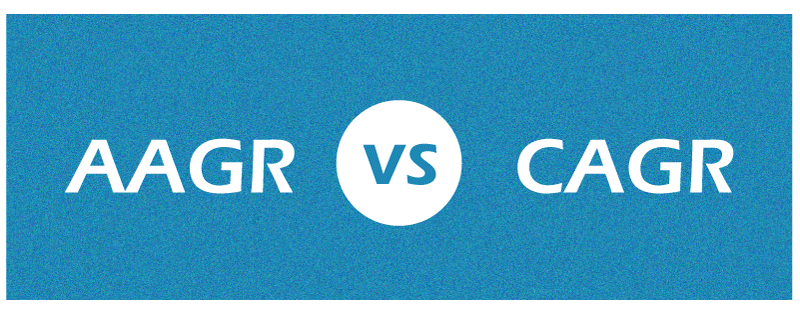Average Annual Growth Rate (AAGR): Definition and CalculationWhat is AAGR?The average annual growth rate (AAGR) is the average yearly increase in the value of a portfolio, cash flow, or investment asset, and it is calculated by averaging out the given or calculated annual growth rates. Typically, the AAGR is shown as a percentage. Compounding and any investment risks (like market volatility) are not taken into account while calculating AAGR. 
Understanding AAGRLong-term trends can be determined using the average annual growth rate. The ratio indicates the average yearly return. It can be used in nearly any type of financial statistic, like growth rates of revenues, sales, cash flow, expenses, etc., to give investors a sense of the direction the firm is heading. The simple average of a series of growth rates is used to get the AAGR. Any investment can have its AAGR computed, but it won't include any information about how risky the investment is overall, as determined by price volatility. Moreover, periodic compounding is not taken into consideration by the AAGR. AAGR is a standard for calculating the annualised average return on investments over a range of time periods. This number can be found in the prospectus of a mutual fund as well as in brokerage statements. It is the simple arithmetic mean of a sequence of periodic return growth rates. One thing to note is not to combine different time periods; each period should have the same length, such as years, months, or weeks. Formula for AAGRThe formula for AAGR is defined below:
Average Annual Growth Rate = (G(A) + G(B) + G(C).........+G(n)) / N
Here, G(A) = Growth Rate in year A G(B) = Growth Rate in year B G(n) = Growth Rate in year n N = Total number of Periods Why is the AAGR calculation important?AAGR must be calculated in order to be utilised in financial analysis. It is employed to identify trends in a year and can be compared to growth over several years. The analysis of sales in a particular year and future financial decisions can be made using annual growth percentages. One can evaluate performance over equal periods using AAGR. Once the data has been collected, one can mix growth periods to study numerous data points. Nearly any financial data may be calculated using AAGR values. Example of Average Annual Growth RateThe average rate of return or growth is measured by the AAGR across several equally spaced time intervals. Consider, for illustration, four-year investments with the values as follows:
The following equation can be used to calculate the annual percentage growth: Simple percentage growth or return = (beginning value/ending value) - 1 The following are the rates of growth for each year:
The AAGR is determined by adding the annual growth rates and dividing the result by the number of years, so: AAGR = (16.67% + 10.71% + 16.13% + 22.22%) / 4 = 16.44% The opening and ending prices are typically applied in financial and accounting contexts. Based on what is being evaluated, some analysts might prefer to utilise average prices when computing the AAGR. Compound Annual Growth Rate (CAGR) vs. AAGR
AAGR is a linear metric that does not consider compounding effects. The instance above demonstrates that the investment increased by an average of 16.44% annually. The average yearly growth rate helps depict trends, but since it does not correctly reflect changing financials, it can be deceiving to analysts. It occasionally overestimates the rate of return on investment. Consider, for the AAGR instance above, a $120,000 Investment value for year 5. Year 5's percentage growth rate is -45.45%. The resulting AAGR would be 4.1%; however, it is clear from the initial value of year 1 and the final value of year 5 that the performance generates a 0% return. Depending on the circumstance, the CAGR calculation might be more beneficial. CAGR FormulaCAGR = ( (Ending Balance / Beginning Balance) ^ (1 / #years) ) - 1 Considering the above illustration for the year 1 to 4, the CAGR is: CAGR = ( ($220,000 / $120,000) ^ (1/4) ) - 1 = 16.36% The AAGR and CAGR are comparable for the initial four years. Nevertheless, if year 5 were included in the CAGR calculation, the outcome would be 0%, which stands in stark contrast to the AAGR's result of 4.1%. LimitationsAAGR is an arithmetic mean of periodic yearly returns; it excludes any assessment of the overall risk of the investment as determined by the price volatility. For instance, the average yearly growth rate would be estimated as 25% if a portfolio experienced net annual growth of 20% in the first year and 30% the following year. In order to avoid measurement mistakes, the changes in the investment's return rate between the start of the first year and the end of the year are not considered in the calculations. Another problem is that it does not take into account the timing of returns because it is a simple average. For example, an abrupt 45.45% fall in year 5, in the illustration above, has a moderate effect on overall average yearly growth. However, because timing is crucial, CAGR might be more helpful in comprehending why time-chained growth rates are significant.
Next TopicPayee
|
 For Videos Join Our Youtube Channel: Join Now
For Videos Join Our Youtube Channel: Join Now
Feedback
- Send your Feedback to [email protected]
Help Others, Please Share









